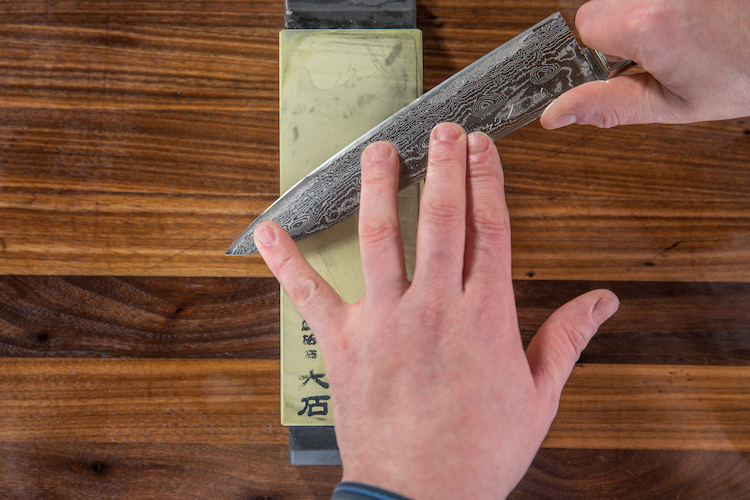Having a good set of knives in the kitchen is the equivalent of having a trusty tool in a toolbox. As the heart of a functional and stylish kitchen, they bring accuracy and ease to meal preparation. These sharp and precise objects make cooking and food preparation tasks much easier, especially when dealing with Japanese cuisine. Given the precise and often delicate nature of their traditional dishes, you need a reliable set to ensure that your dishes come out perfectly.
However, owning these high-quality knives also means taking good care of them to keep them sharp and functional for many years to come. It doesn’t matter if you only use them occasionally or if you’re a professional chef, proper maintenance is crucial for the longevity and performance of your knives.
How Do You Take Care of Japanese Knives?
If you consider the time and effort put into crafting these beautiful blades, it’s only fair that you give them the necessary care to maintain their sharpness. More often than not, it takes just a few simple steps to keep them in top-notch condition.
Store Them in Protective Sheaths

source: chefsarmoury.com
To prevent accidental cuts and maintain the sharpness of your blades, you need to use a specialised knife sheath that fits the shape and size of your set. These protective covers help to protect the blades from coming into contact with other metal objects, which can cause them to dull or chip. They’re normally made of sturdy materials such as wood or plastic and can be easily found in kitchenware shops or online. They follow the distinct shape of traditional Japanese knives, with a notch for the handle so you can easily take them out when needed.
One particularly interesting detail about knife sheaths is that they usually fit more than one type of blade, so you can store multiple knives in the same sheath if they share similar dimensions. For instance, Saya covers can accommodate a Makoto Sakura, Kaiden Kodo, or even a Konosuke knife. This inherently boosts the durability of your knives by protecting them from a variety of potential damages.
If you want to store your blades in a drawer or knife block, it’s essential to wrap them individually or place them in sheaths to avoid any collisions with other utensils. Given the durable nature of a knife sheath set, you’ll effectively be minimizing the risk of your knives getting damaged.
Sometimes, they may require a final fitting to ensure that the blade sits correctly before storage. This is quite common with older knives or those that have had their blades sharpened, given that they’ll have somewhat thinner edges. To do this, simply use a small metal file or saw to create a small groove in the sheath before inserting the blade. This will give it a more secure fit, preventing it from moving around and potentially damaging your blades.
Avoid Using Dishwashers
While it may seem convenient to toss your knives in the dishwasher after use, it’s not always the best option for maintaining their sharpness. Dishwashers use high temperatures and harsh detergents that can cause damage to your knives, especially if they have wooden handles. The heat can cause the wood to warp or crack, decreasing its durability and potentially affecting its performance.
Additionally, the constant jostling and rubbing against other utensils in a dishwasher can dull or chip the blades of your knives, making them less effective when cutting through food. It’s always best to hand wash your Japanese knives with lukewarm water and mild soap immediately after use.
Dry Your Knives Immediately After Washing
It’s essential to dry your knives immediately after washing them to prevent any moisture from causing rust or corrosion on the blade. This is particularly important if your knife has a high carbon content, which is prone to corrosion if not properly maintained. Use a clean and dry cloth to wipe the blade thoroughly before storing it in its protective sheath.
If you notice a build-up of stubborn food particles or oils on the blade, you can use a non-abrasive scrubber and some baking soda to gently remove them. Avoid using steel wool or harsh cleaning products as they can scratch or damage the surface of your knives.
Hone Your Blades Regularly

source: chefsteps.com
Even with proper storage and cleaning habits, every now and then, your knives will need a bit of maintenance to keep their sharpness. Honing your blades regularly helps to realign any bent or misaligned parts of the edge that may have occurred during use. This simple process involves running the knife along a honing steel at an angle while applying light pressure on both sides of the blade.
Use the Right Cutting Board
Another essential aspect of maintaining your Japanese knives is using the right cutting board. Wooden or plastic cutting varieties are the best options as they are less likely to damage your blades compared to harder surfaces like granite or ceramic. Avoid using glass cutting boards at all costs, as they can dull and even chip your knives due to their high hardness levels.
Don’t Use Your Knives as a Pry Bar or Screwdriver
Finally, it’s essential to use your knives for their intended purpose only – cutting food. Using them as a makeshift screwdriver or prying tool can cause significant damage and breakage, rendering them useless. Keep them sharp by using them for what they were designed for – precision cutting and slicing.
If you need to loosen or tighten screws or pry open containers, use the appropriate tools instead. This simple step will go a long way in maintaining the condition of your knives and ensuring their longevity. Avoid using them to cut through frozen foods or bones as well, as this can cause the blades to chip or break.

